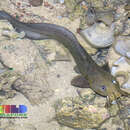Diagnostic Description
(
Inglês
)
fornecido por Fishbase
A plain dusky-brown species with a black dorsal fin tip. Shows banded pattern at night. Distinguished from adult Plotosus lineatus by its long barbels on the nostrils that can reach pass the eyes.
- licença
- cc-by-nc
- direitos autorais
- FishBase
Diseases and Parasites
(
Inglês
)
fornecido por Fishbase
Heteronsentis Infestation. Parasitic infestations (protozoa, worms, etc.)
- licença
- cc-by-nc
- direitos autorais
- FishBase
Migration
(
Inglês
)
fornecido por Fishbase
Amphidromous. Refers to fishes that regularly migrate between freshwater and the sea (in both directions), but not for the purpose of breeding, as in anadromous and catadromous species. Sub-division of diadromous. Migrations should be cyclical and predictable and cover more than 100 km.Characteristic elements in amphidromy are: reproduction in fresh water, passage to sea by newly hatched larvae, a period of feeding and growing at sea usually a few months long, return to fresh water of well-grown juveniles, a further period of feeding and growing in fresh water, followed by reproduction there (Ref. 82692).
- licença
- cc-by-nc
- direitos autorais
- FishBase
- Recorder
- Crispina B. Binohlan
Trophic Strategy
(
Inglês
)
fornecido por Fishbase
Occurs in the inshore waters (Ref. 75154). Feeds on benthic animals and fish (Ref. 3478).
- licença
- cc-by-nc
- direitos autorais
- FishBase
Biology
(
Inglês
)
fornecido por Fishbase
Adults found mostly in estuaries and lagoons, and sometimes up rivers in nearly fresh waters. They occur in the lower parts of rivers in freshwater or brackish water and in coastal seas (Ref. 12693, 48635). It is reported to have an extended breeding season and likely spawns in brackish water, based on optimal sperm survival at 0.9 % salinity; produces relatively few large eggs, consistent with parental care and it is possible that male fish construct nests and guard their fry (Ref. 127983), Maximum length of 150 cm TL is without actual specimen (Ref. 3478). Juveniles may occur in dense aggregations (Ref. 9801). Feed on crustaceans, mollusks and fishes. Spines associated with anterior fins have potent venom. Marketed mostly fresh.
- licença
- cc-by-nc
- direitos autorais
- FishBase
- Recorder
- Crispina B. Binohlan
Importance
(
Inglês
)
fornecido por Fishbase
fisheries: commercial
- licença
- cc-by-nc
- direitos autorais
- FishBase
- Recorder
- Crispina B. Binohlan
Plotosus canius
(
Inglês
)
fornecido por wikipedia EN
- licença
- cc-by-sa-3.0
- direitos autorais
- Wikipedia authors and editors
Plotosus canius: Brief Summary
(
Inglês
)
fornecido por wikipedia EN
Plotosus canius is a species of eeltail catfish, in the genus Plotosus, native to the Indian Ocean, the western Pacific Ocean and New Guinea.
- licença
- cc-by-sa-3.0
- direitos autorais
- Wikipedia authors and editors

